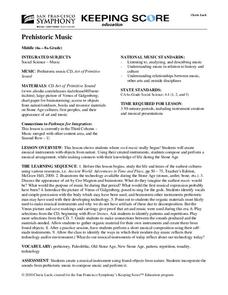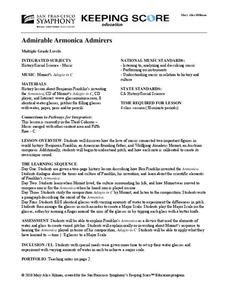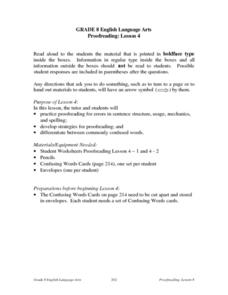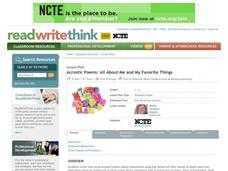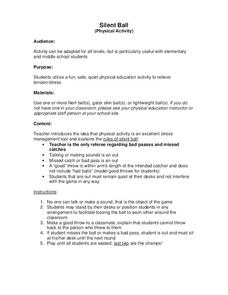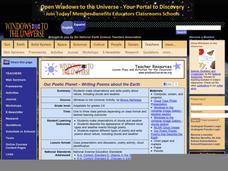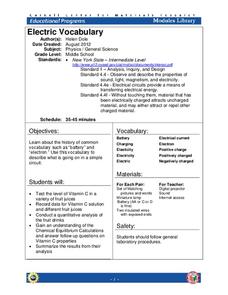Curated OER
Quick and Sticky Context Clues
Discuss strategies for defining word your young readers don't know. They read sentences with key words covered by sticky notes and guess from the context what the word might be. They peek at the first letter and guess again.
Curated OER
Alphabet Photo Book
Students brainstorm words that start with each letter of the alphabet, take digital pictures of words that start with assigned letter, and use iPhoto to create class alphabet book.
Curated OER
Rhythm and Rhyme
Youngsters listen to poetry and music to understand that words are made of sounds. In this rhythm and rhyme lesson, students create songbooks of healthy eating songs. They will also act out pantomimes and dance to the music....
Curated OER
Boogie Woogie with a B: Using Alliteration while Exploring Patriotic Tunes
Are you looking for a way to bring writing into your history lesson - or history into your writing lesson? This cross-curricular activity is helpful and fun, no matter what class you're teaching! Using "Boogie Woogie Bugle Boy" by the...
Planet e-Book
Dubliners
The Dubliners contains 15 short stories all bound in one book. The stories begin with narration by young children, and as they progress, so do the ages of the narrators. The author, James Joyce, focuses most stories on characters that...
K12 Reader
Alliteration Adventures
Assign a learning exercise to reinforce the literary device of alliteration. Scholars choose a letter, brainstorm a variety of nouns, verbs, and adjectives that begin with that letter, then write three sentences using the words they...
Curated OER
Beginning Sounds: A is for Ant
The ABC's and beginning letter sounds are the foundation of strong reading skills. Use this presentation to build your young learner's abilities to recognize beginning sounds and alphabet letters. Each slide contains an image and a word...
San Francisco Symphony
Prehistoric Music
What was music like during the Stone Age? Learners listen to a CD entitled, Art of Primitive Sound as they consider the culture of people in the Stone Age. They use objects found in nature to create instruments, and then...
San Francisco Symphony
Admirable Armonica Admirers
What do Ben Franklin and Wolfgang Mozart have in common? Find out about the musical invention, the armonica or glassy-chord. Learners will read about how Ben Franklin invented this new instrument and how Wolfgang Mozart came to play it....
Curated OER
Use Digital Photos of Scary Things to Inspire Poetry Writing
There's nothing like a provocative image to inspire a creative writing session. In the language arts instructional activity presented here, middle schoolers bring in digital photos of scary objects, such as a big spider, or a hornet's...
Arizona State University
They're, Their, and They're
Clear up the difference between they're, their, and there once and for all! A reference sheets outlines when your learners can use each word, and ten practice sentences encourage them to fill the appropriate word in the blank. Use this...
Curated OER
Proofreading: Lesson 4
Examine the key strategies to proofreading a piece of writing for errors in sentence structure, usage, mechanics and spelling. Eighth graders practice putting into correct passage commonly confused words (too, two, to) when writing to a...
K12 Reader
The Important Apostrophe: Their, They’re, and There
They're going to be there with their family. Class members practice using and identifying the correct use of they're, there, and their with a skills practice worksheet. The top half of the worksheet gives brief background information on...
National Council of Teachers of English
Acrostic Poems: All About Me and My Favorite Things
Budding poets create two acrostic poems, one for their name and another using a word of their choice. Over the course of five days, scholars compose, revise, publish, and share their work with their peers.
Utah Education Network (UEN)
8th Grade Poetry: Sonnet Poem
The third lesson of five in an eighth-grade poetry unit has young scholars comparing Shakespearean sonnets with Petrarchan sonnets. To begin, they examine the different structures of the two forms and their different rhyme schemes. After...
San Francisco Unified School District
Silent Ball
Just as you've lined up the class to go to recess, it begins pouring rain and all chaos breaks loose. What do you do? It's time for silent ball! The rules include no talking, and you must catch the ball. If you talk, drop the...
Curated OER
French and Family
Where is France? Interest young learners in exploring France, French language, and French culture. They identify similarities and differences between French and American families, speak the French words for family members, analyze maps,...
Curated OER
The News Behind the Story
What a fun way to analyze plot, setting, and character. Learners review story elements, read a short fictional story, then turn the events of that story into a headlining news paper article. Not only does this lesson engage critical...
Curated OER
Writing a Newspaper-Style Article
Help your secondary reader/writers assess texts by studying press releases from Statistics Canada and drafting articles based on them. They then compare the press release, their own articles, and actual news stories they find online. I'd...
Curated OER
Our Poetic Planet - Writing Poems about the Earth
As a way to combine language arts and science, try this lesson on writing cloud poetry. Begin by showing a PowerPoint presentation and images of cloud types. Take meteorology masters outdoors to explore the sky using the provided "Cloud...
Maine Content Literacy Project
Dramatic Structure of the Short Story
The second lesson in a series of fourteen, this plan takes the short story basics a step further. Learners complete a quiz about the story from the previous day, discuss the text, learn about Anton Chekhov, and work in groups to begin...
National Energy Education Development Project
The Science of Energy
Did you know the word energy comes from energeia, a Greek word? Introduce learners to the four types of potential energy, five types of kinetic energy, and energy transformation with a presentation about where we get our energy and...
Cornell University
Electric Vocabulary
Practice electric vocabulary using multiple methods. Learners begin by watching a video that explains vocabulary related to electric currents. They match vocabulary cards to practice and then create an electric circuit. Using the...
Center for Learning in Action
Introduction to Matter
Begin your states of matter lessons with a demonstration designed to introduce the concept that all matter has properties. Reinforce this concept through vocabulary exploration, and the creation of atom models; salt, water, and carbon...









